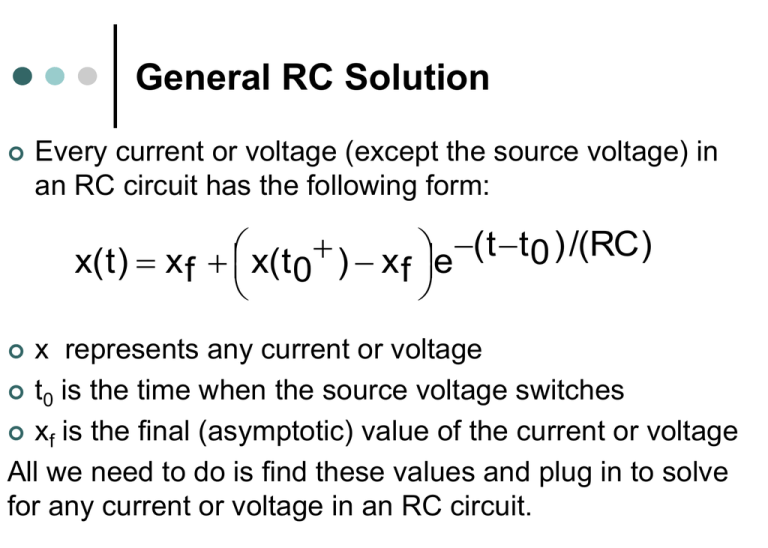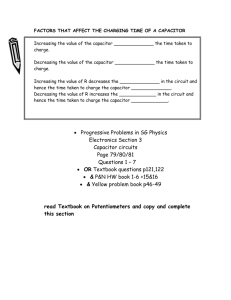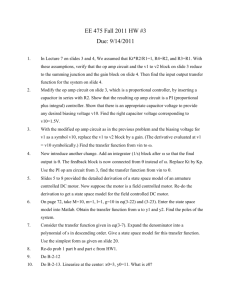Review of exponential charging and discharging in RC Circuits
advertisement

General RC Solution Every current or voltage (except the source voltage) in an RC circuit has the following form: ( t t ) /( RC ) 0 x( t ) x f x( t0 ) x f e x represents any current or voltage t0 is the time when the source voltage switches xf is the final (asymptotic) value of the current or voltage All we need to do is find these values and plug in to solve for any current or voltage in an RC circuit. Solving the RC Circuit We need the following three ingredients to fill in our equation for any current or voltage: x(t0+) This is the current or voltage of interest just after the voltage source switches. It is the starting point of our transition, the initial value. xf This is the value that the current or voltage approaches as t goes to infinity. It is called the final value. RC This is the time constant. It determines how fast the current or voltage transitions between initial and final value. Example R1 = 10 kW t=0 I + Vs = 5 V Find the current I(t). R2 = 5 kW C = 1 mF Finding the Initial Condition To find x(t0+), the current or voltage just after the switch, we use the following essential fact: Capacitor voltage is continuous; it cannot jump when a switch occurs. So we can find the capacitor voltage VC(t0+) by finding VC(t0-), the voltage before switching. We can assume the capacitor was in steady-state before switching. The capacitor acts like an open circuit in this case, and it’s not too hard to find the voltage over this open circuit. We can then find x(t0+) using VC(t0+) using KVL or the capacitor I-V relationship. These laws hold for every instant in time. Example: Initial Condition R1 = 10 kW t=0 I + Vs = 5 V R2 = 5 kW C = 1 mF We first find capacitor voltage right after the switch, (at t=0+) and use it to find the current I at t=0+. To do this, we look at the circuit before switching, because the capacitor voltage will remain the same after switching. Assuming the circuit has been “unswitched” for a long time, the capacitor acts like an open circuit connected to a resistor. The capacitor voltage before switching (at t=0-) is 0 V. The capacitor voltage after switching (at t=0+) is 0 V. Example: Initial Condition R1 = 10 kW + 5V + Vs = 5 V R2 = 5 kW t=0 I + 0V _ C = 1 mF We know the capacitor voltage is 0 V right after the switch. By KVL, the resistor gets all 5 V that the source puts out. So by Ohm’s law, I(0+) is 5 V / 10 kW = 0.5 mA Finding the Final Value To find xf , the asymptotic final value, we assume that the circuit will be in steady-state as t goes to infinity. So we assume that the capacitor is acting like an open circuit. We then find the value of current or voltage we are looking for using this open-circuit assumption. Here, we use the circuit after switching along with the open-circuit assumption. When we found the initial value, we applied the open-circuit assumption to the circuit before switching, and found the capacitor voltage which would be preserved through the switch. Example: Final Value R1 = 10 kW t=0 I + Vs = 5 V R2 = 5 kW C = 1 mF After the circuit has been switched for a long time, the capacitor will act like an open circuit. Then no current can flow—eventually, I goes to zero. If = 0 A Finding the Time Constant It seems easy to find the time constant: it equals RC. But what if there is more than one resistor or capacitor? R is the Thevenin equivalent resistance with respect to the capacitor terminals. Remove the capacitor and find RTH. It might help to turn off the voltage source. Use the circuit after switching. We will discuss how to combine capacitors in series and in parallel in the next lecture. Example: Time Constant R1 = 10 kW t=0 I + Vs = 5 V R2 = 5 kW C = 1 mF How long does it take for the current to converge after switching? Look at the circuit after switching to find the time constant. The 5 kW resistor is not “in” the circuit after the switch. R = 10 kW, C = 1 mF so t = 10 s Example: Final Answer R1 = 10 kW t=0 I + Vs = 5 V R2 = 5 kW Plugging in, we get: I(t) = If + (I(0+) – If) e-t/RC I(t) = 0 + (0.5 mA – 0) e-t/10 = 0.5 e-t/10 mA C = 1 mF Alternative Method Instead of finding these three ingredients for the generic current or voltage x, we can Find the initial and final capacitor voltage (it’s easier) Find the time constant (it’s the same for everything) Form the capacitor voltage equation VC(t) Use KVL or the I-V relationship to find x(t) Example: Alternative Method R1 = 10 kW t=0 I + Vs = 5 V R2 = 5 kW The initial capacitor voltage was VC(0+) = 0 V. The time constant is t = 10 s. C = 1 mF The final value of the capacitor voltage, when the capacitor has gone to an open circuit, is VC,F = 5 V. Plug in to get V (t) = 5 – 5 e-t/10 V. Since I = C dV/dt, C I(t) = (10-3)((-5)/(-10) e-t/10 A Series and Parallel Capacitors Capacitors combine the opposite way as compared to resistors. C1 C1 C2 C2 C3 C3 = = C1 + C2 + C3 (1/C1 + 1/C2 + 1/C3)-1 Hard Example 1 kW 5V t=0 + V1 _ 1 kW + V2 _ 2 F 2 F 1 kW Find V1(t) and V2(t). Find the energy absorbed by the resistors for t > 0. Initial Conditions 1 kW 5V t=0 + V1 _ 1 kW + V2 _ 2 F 2 F 1 kW Consider the circuit before the switch—it had been that way for a long time. Assume second capacitor is discharged at t=0. Time Constant 1 kW 5V t=0 + V1 _ 1 kW + V2 _ 2 F 1 kW How long does it take to converge after switch? What are R and C? 2 F Final Value 1 kW 5V t=0 + V1 _ 1 kW + V2 _ 2 F 2 F 1 kW After a while, both capacitors are open circuits. They can have nonzero voltage, but voltages must be equal. Equate V = Q/C for capacitors to gain insight into final value… Solutions Energy is time integral of power. Find P = VI = R(I2). DRAM Dynamic Random Access Memory (DRAM) cells are really just capacitors. Each capacitor is one bit. The circuit we just saw simulates the writing and reading of a DRAM cell (capacitor 1). A logic gate that needed to use the contents of the DRAM cell would be represented by an RC circuit, and the DRAM capacitor would need to charge the logic gate’s natural capacitance. DRAM capacitors are connected to electronic switches, not physical switches. So there is always a little current flowing. This drains the charge from the DRAM capacitors. They need to be “refreshed” periodically. Hence the term dynamic.


![Sample_hold[1]](http://s2.studylib.net/store/data/005360237_1-66a09447be9ffd6ace4f3f67c2fef5c7-300x300.png)


